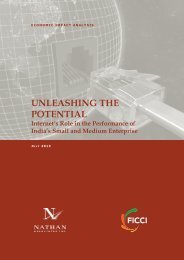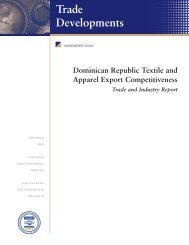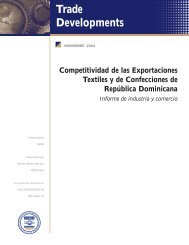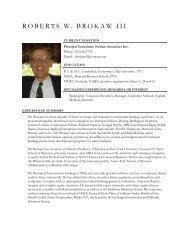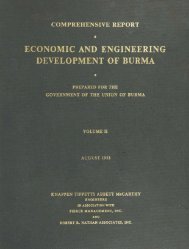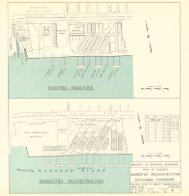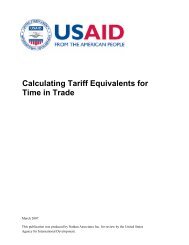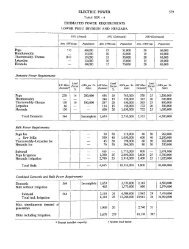Putting it to Work in Developing Countries - Nathan Associates
Putting it to Work in Developing Countries - Nathan Associates
Putting it to Work in Developing Countries - Nathan Associates
Create successful ePaper yourself
Turn your PDF publications into a flip-book with our unique Google optimized e-Paper software.
Figure 4-5<br />
Selected Manufactur<strong>in</strong>g Industries: Change <strong>in</strong> Develop<strong>in</strong>g<br />
<strong>Countries</strong>' Share of Global S<strong>to</strong>ck of Inward FDI, 1990-2004<br />
Percentage po<strong>in</strong>t<br />
25<br />
20<br />
22<br />
15<br />
10<br />
5<br />
0<br />
-5<br />
-10<br />
-15<br />
-20<br />
1<br />
-10<br />
-4<br />
-3<br />
-17<br />
-1 -1<br />
-13<br />
-2<br />
5<br />
-2<br />
-5<br />
Food, beverages,<br />
and <strong>to</strong>bacco<br />
Textiles, cloth<strong>in</strong>g and<br />
leather<br />
Wood and<br />
wood products<br />
Publish<strong>in</strong>g, pr<strong>in</strong>t<strong>in</strong>g,<br />
recorded media reproduction<br />
Coke, petroleum products,<br />
and nuclear fuel<br />
Chemicals and<br />
chemical products<br />
Rubber and<br />
plastic products<br />
Non-metallic<br />
m<strong>in</strong>eral products<br />
Metal and metal<br />
products<br />
Mach<strong>in</strong>ery and<br />
equipment<br />
Electrical and<br />
electronic equipment<br />
Precision<br />
<strong>in</strong>struments<br />
Mo<strong>to</strong>r vehicles/ other<br />
transport equipment<br />
Note: Includes all countries classified as “develop<strong>in</strong>g” by UNCTAD. UNCTAD classifies some countries as develop<strong>in</strong>g<br />
that the World Bank considers “high <strong>in</strong>come,” such as S<strong>in</strong>gapore and South Korea, and classifies some as developed<br />
that the World Bank considers “low and middle <strong>in</strong>come,” such as Es<strong>to</strong>nia, the Czech Republic, and Hungary. Data for<br />
the countries <strong>in</strong> UNCTAD’s “South-East Europe and the Commonwealth of Independent States” category are<br />
<strong>in</strong>cluded <strong>in</strong> the develop<strong>in</strong>g country <strong>to</strong>tals for 2004, but data for these countries are not available by sec<strong>to</strong>r and<br />
<strong>in</strong>dustry for 1990.<br />
SOURCE: <strong>Nathan</strong> <strong>Associates</strong>, based on UNCTAD, World Investment Report 2006, Annex Table A.1.2.<br />
<strong>in</strong> FDI <strong>in</strong>ward s<strong>to</strong>ck <strong>in</strong> publish<strong>in</strong>g, pr<strong>in</strong>t<strong>in</strong>g,<br />
and reproduction of recorded media.<br />
In such <strong>in</strong>dustries, production is <strong>in</strong>creas<strong>in</strong>gly<br />
technology-<strong>in</strong>tensive, w<strong>it</strong>h cap<strong>it</strong>al and knowledge<br />
replac<strong>in</strong>g labor. In a modern au<strong>to</strong>mobile<br />
plant, only a few workers mon<strong>it</strong>or a highly au<strong>to</strong>mated<br />
production process while others are<br />
engaged <strong>in</strong> purchas<strong>in</strong>g, <strong>in</strong>ven<strong>to</strong>ry, logistics, and<br />
f<strong>in</strong>ance. In this k<strong>in</strong>d of manufactur<strong>in</strong>g, comparative<br />
advantage cannot be based on labor cost<br />
alone, but must build on other fac<strong>to</strong>rs: worker<br />
skill, worker health, transport costs, logistics<br />
efficiency, design, market<strong>in</strong>g, <strong>in</strong>ven<strong>to</strong>ry<br />
management. Coupled w<strong>it</strong>h the disaggregation<br />
of value cha<strong>in</strong>s, the consequence is that many<br />
manufactur<strong>in</strong>g activ<strong>it</strong>ies have begun <strong>to</strong> look like<br />
services, re<strong>in</strong>forc<strong>in</strong>g the shift <strong>to</strong> services.<br />
Accord<strong>in</strong>gly, the appeal of low-cost labor <strong>in</strong><br />
develop<strong>in</strong>g countries is dim<strong>in</strong>ish<strong>in</strong>g.<br />
IMPLICATIONS FOR THE “LADDER EFFECT”<br />
Changes <strong>in</strong> manufactur<strong>in</strong>g have two implications<br />
for develop<strong>in</strong>g countries. First, the “ladder<br />
effect” for channel<strong>in</strong>g FDI flows will cont<strong>in</strong>ue<br />
<strong>to</strong> operate, but more rapidly and perhaps w<strong>it</strong>h<br />
more rungs at the <strong>to</strong>p than the bot<strong>to</strong>m. As<br />
countries cost themselves out of simpler,<br />
48



